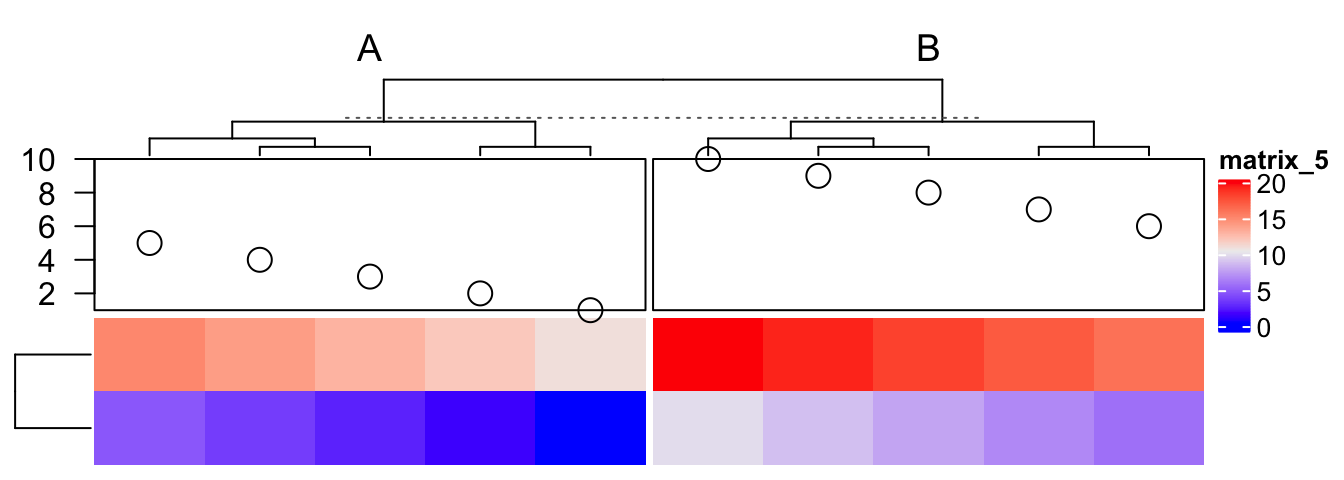Chapter 3 Heatmap Annotations
Heatmap annotations are important components of a heatmap that it shows
additional information that associates with rows or columns in the heatmap.
ComplexHeatmap package provides very flexible supports for setting
annotations and defining new annotation graphics. The annotations can be put
on the four sides of the heatmap, by top_annotation, bottom_annotation,
left_annotation and right_annotation arguments.
The value for the four arguments should be in the HeatmapAnnotation class
and should be constructed by HeatmapAnnotation() function, or by
rowAnnotation() function if it is a row annotation. (rowAnnotation() is
just a helper function which is identical to HeatmapAnnotation(..., which = "row")) A simple usage of heatmap annotations is as follows.
set.seed(123)
mat = matrix(rnorm(100), 10)
rownames(mat) = paste0("R", 1:10)
colnames(mat) = paste0("C", 1:10)
column_ha = HeatmapAnnotation(foo1 = runif(10), bar1 = anno_barplot(runif(10)))
row_ha = rowAnnotation(foo2 = runif(10), bar2 = anno_barplot(runif(10)))
Heatmap(mat, name = "mat", top_annotation = column_ha, right_annotation = row_ha)
Or assign as bottom annotation and left annotation.

In above examples, column_ha and row_ha both have two annotations where
foo1 and foo2 are numeric vectors and bar1 and bar2 are barplots. The
vector-like annotation is called “simple annotation” here and the barplot
annotation is called “complex annotation”. You can already see the
annotations must be defined as name-value pairs (e.g. foo = ...).
Heatmap annotations can also be independent of the heatmaps. They can be
concatenated to the heatmap list by + if it is horizontal or %v% if it is
vertical. Chapter 4 will discuss how to concatenate
heatmaps and annotations.
# code only for demonstration
Heatmap(...) + rowAnnotation() + ...
Heatmap(...) %v% HeatmapAnnotation(...) + ...HeatmapAnnotation() returns a HeatmapAnnotation class object. The object
is usually composed of several annotations. If following sections of this
chapter, we first introduce settings for individal annotation, and later we
show how to put them toghether.
You can see the information of the column_ha and row_ha objects:
## A HeatmapAnnotation object with 2 annotations
## name: heatmap_annotation_0
## position: column
## items: 10
## width: 1npc
## height: 15.3514598035146mm
## this object is subsetable
## 5.92288888888889mm extension on the left
## 9.4709mm extension on the right
##
## name annotation_type color_mapping height
## foo1 continuous vector random 5mm
## bar1 anno_barplot() 10mm## A HeatmapAnnotation object with 2 annotations
## name: heatmap_annotation_1
## position: row
## items: 10
## width: 15.3514598035146mm
## height: 1npc
## this object is subsetable
## 9.96242222222222mm extension on the bottom
##
## name annotation_type color_mapping width
## foo2 continuous vector random 5mm
## bar2 anno_barplot() 10mmIn following examples in this chapter, we will only show the graphics for the
annotations with no heatmap, unless it is necessary. If you want to try it
with a heatmap, you just assign the HeatmapAnnotation object which we always
name as ha to top_annotation, bottom_annotation, left_annotation or
right_annotation arguments.
Settings are basically the same for column annotations and row annotations. If
there is nothing specicial, we only show the column annotation as examples. If
you want to try row annotation, just add which = "row" to
HeatmapAnnotation() or directly change to rowAnnotation() function.
3.1 Simple annotation
A so-called “simple annotation” is the most used style of annotations which
is heatmap-like or grid-like graphics where colors are used to map to the
anntation values. To generate a simple annotation, you just simply put the
annotation vector in HeatmapAnnotation() with a specific name.

Or a discrete annotation:

You can use any strings as annotation names except those pre-defined arguments
in HeatmapAnnotation().
If colors are not specified, colors are randomly generated. To set the colors
for annotation, col needs to be set as a named list. For continuous values,
the color mapping should be a color mapping function generated by
circlize::colorRamp2().
library(circlize)
col_fun = colorRamp2(c(0, 5, 10), c("blue", "white", "red"))
ha = HeatmapAnnotation(foo = 1:10, col = list(foo = col_fun))
And for discrete annotations, the color should be a named vector where names correspond to the levels in the annotation.
ha = HeatmapAnnotation(bar = sample(letters[1:3], 10, replace = TRUE),
col = list(bar = c("a" = "red", "b" = "green", "c" = "blue")))
If you specify more than one vectors, there will be multiple annotations
(foo and bar in following example). Also you can see how col is set when
foo and bar are all put into a single HeatmapAnnotation(). Maybe now you
can understand the names in the color list is actually used to map to the
annotation names. Values in col will be used to construct legends for simple
annotations.
ha = HeatmapAnnotation(
foo = 1:10,
bar = sample(letters[1:3], 10, replace = TRUE),
col = list(foo = col_fun,
bar = c("a" = "red", "b" = "green", "c" = "blue")
)
)
The color for NA value is controlled by na_col argument.
ha = HeatmapAnnotation(
foo = c(1:4, NA, 6:10),
bar = c(NA, sample(letters[1:3], 9, replace = TRUE)),
col = list(foo = col_fun,
bar = c("a" = "red", "b" = "green", "c" = "blue")
),
na_col = "black"
)
gp mainly controls the graphic parameters for the borders of the grids.
ha = HeatmapAnnotation(
foo = 1:10,
bar = sample(letters[1:3], 10, replace = TRUE),
col = list(foo = col_fun,
bar = c("a" = "red", "b" = "green", "c" = "blue")
),
gp = gpar(col = "black")
)
The simple annotation can also be a matrix (numeric or character) that all the columns in the matrix share a same color mapping schema. Note columns in the matrix correspond to the rows in the column annotation. Also the column names of the matrix are used as the annotation names.

If the matrix has no column name, the name of the annotation is still used, but drawn in the middle of the annotation.

As simple annotations can be in different modes (e.g. numeric, or character),
they can be combined as a data frame and send to df argument. Imaging in your
project, you might already have an annotation table, you can directly set it by
df.
anno_df = data.frame(foo = 1:10,
bar = sample(letters[1:3], 10, replace = TRUE))
ha = HeatmapAnnotation(df = anno_df,
col = list(foo = col_fun,
bar = c("a" = "red", "b" = "green", "c" = "blue")
)
)
Single annotations and data frame can be mixed. In following example, colors
for foo2 is not specified, random colors will be used.
ha = HeatmapAnnotation(df = anno_df,
foo2 = rnorm(10),
col = list(foo = col_fun,
bar = c("a" = "red", "b" = "green", "c" = "blue")
)
)
border controls the border of every single annotation.
ha = HeatmapAnnotation(
foo = cbind(1:10, 10:1),
bar = sample(letters[1:3], 10, replace = TRUE),
col = list(foo = col_fun,
bar = c("a" = "red", "b" = "green", "c" = "blue")
),
border = TRUE
)
The height of the simple annotation is controlled by simple_anno_size
argument. Since all single annotations have same height, the value of
simple_anno_size is a single unit value. Note there are arguments like
width, height, annotation_width and annotation_height, but they are
used to adjust the width/height for the complete heamtap annotations (which
are always mix of several annotations). The adjustment of these four arguments
will be introduced in Section 3.18.
ha = HeatmapAnnotation(
foo = cbind(a = 1:10, b = 10:1),
bar = sample(letters[1:3], 10, replace = TRUE),
col = list(foo = col_fun,
bar = c("a" = "red", "b" = "green", "c" = "blue")
),
simple_anno_size = unit(1, "cm")
)
When you have multiple heatmaps and it is better to keep the size of simple
annotations on all heatmaps with the same size. ht_opt$simple_anno_size can
be set to control the simple annotation size globally (It will be introduced
in Section 4.13).
3.2 Simple annotation as an annotation function
HeatmapAnnotation() supports “complex annotation” by setting the
annotation as a function. The annotation function defines how to draw the
graphics at a certain position corresponding to the column or row in the
heatmap. There are quite a lot of annotation functions predefined in
ComplexHeatmap package. In the end of this chapter, we will introduce how
to construct your own annotation function by the AnnotationFunction class.
For all the annotation functions in forms of anno_*(), if it is specified in
HeatmapAnnotation() or rowAnnotation(), you don’t need to do anything
explicitly on anno_*() to tell whether it should be drawn on rows or
columns. anno_*() automatically detects whether it is a row annotation
environment or a column annotation environment.
The simple annotation shown in previous section is internally constructed by
anno_simple() annotation function. Directly using anno_simple() will not
automatically generate legends for the final plot, but, it can provide more
flexibility for more annotation graphics (note In Chapter
5 we will show, although anno_simple() cannot automatically generate the
legends, the legends can be controlled and added to the final plot manually).
For an example in previous section:
is actually identical to:
anno_simple() makes heatmap-like annotations (or the simple annotations).
Basically if users only make heatmap-like annotations, they do not need to
directly use anno_simple(), but this function allows to add more symbols on
the annotation grids.
anno_simple() allows to add “points” or single-letter symbols on top of the
annotation grids. pch, pt_gp and pt_size control the settings of the
points. The value of pch can be a vector with possible NA values.
ha = HeatmapAnnotation(foo = anno_simple(1:10, pch = 1,
pt_gp = gpar(col = "red"), pt_size = unit(1:10, "mm")))
Set pch as a vector:

Set pch as a vector of letters:

Set pch as a vector with NA values (nothing is drawn for NA pch values):

pch also works if the value for anno_simple() is a matrix. The length of
pch should be as same as the number of matrix rows or columns or even the
length of the matrix (the length of the matrix is the length of all data
points in the matrix).
Length of pch corresponds to matrix columns:

Lenght of pch corresponds to matrix rows:

pch is a matrix:
pch = matrix(1:20, nc = 2)
pch[sample(length(pch), 10)] = NA
ha = HeatmapAnnotation(foo = anno_simple(cbind(1:10, 10:1), pch = pch))
Till now, you might wonder how to set the legends of the symbols you’ve added
to the simple annotations. Here we will only show you a simple example and
this functionality will be discussed in Chapter 5. In following
example, we assume the simple annotations are kind of p-values and we add *
for p-values less than 0.01.
set.seed(123)
pvalue = 10^-runif(10, min = 0, max = 3)
is_sig = pvalue < 0.01
pch = rep("*", 10)
pch[!is_sig] = NA
# color mapping for -log10(pvalue)
pvalue_col_fun = colorRamp2(c(0, 2, 3), c("green", "white", "red"))
ha = HeatmapAnnotation(
pvalue = anno_simple(-log10(pvalue), col = pvalue_col_fun, pch = pch),
annotation_name_side = "left")
ht = Heatmap(matrix(rnorm(100), 10), name = "mat", top_annotation = ha)
# now we generate two legends, one for the p-value
# see how we define the legend for pvalue
lgd_pvalue = Legend(title = "p-value", col = pvalue_col_fun, at = c(0, 1, 2, 3),
labels = c("1", "0.1", "0.01", "0.001"))
# and one for the significant p-values
lgd_sig = Legend(pch = "*", type = "points", labels = "< 0.01")
# these two self-defined legends are added to the plot by `annotation_legend_list`
draw(ht, annotation_legend_list = list(lgd_pvalue, lgd_sig))
The height of the simple annotation can be controled by height argument or
simple_anno_size inside anno_simple(). simple_anno_size controls the
size for single-row annotation and height/width controls the total
height/width of the simple annotations. If height/width is set,
simple_anno_size is ignored.


For all the annotation functions we introduce later, the height or the width
for individual annotations should all be set inside the anno_*()
functions.
Again, the width, height, annotation_width and annotation_height
arguments in HeatmapAnnotation() are used to adjust the size of multiple
annotations.
3.3 Empty annotation
anno_empty() is a place holder where nothing is drawn. Later user-defined
graphics can be added by decorate_annotation() function.

In Chapter 6, we will introduce the use of the
decoration functions, but here we give a quick example. In gene expression
expression analysis, there are senarios that we split the heatmaps into
several groups and we want to highlight some key genes in each group. In this
case, we simply add the gene names on the right side of the heatmap without
aligning them to the their corresponding rows. (anno_mark() can align the
labels correclty to their corresponding rows, but in the example we show here,
it is not necessray).
In following example, since rows are split into four slices, the empty annotation is also split into four slices. Basically what we do is in each empty annotation slice, we add a colored segment and text.
random_text = function(n) {
sapply(1:n, function(i) {
paste0(sample(letters, sample(4:10, 1)), collapse = "")
})
}
text_list = list(
text1 = random_text(4),
text2 = random_text(4),
text3 = random_text(4),
text4 = random_text(4)
)
# note how we set the width of this empty annotation
ha = rowAnnotation(foo = anno_empty(border = FALSE,
width = max_text_width(unlist(text_list)) + unit(4, "mm")))
Heatmap(matrix(rnorm(1000), nrow = 100), name = "mat", row_km = 4, right_annotation = ha)
for(i in 1:4) {
decorate_annotation("foo", slice = i, {
grid.rect(x = 0, width = unit(2, "mm"), gp = gpar(fill = i, col = NA), just = "left")
grid.text(paste(text_list[[i]], collapse = "\n"), x = unit(4, "mm"), just = "left")
})
}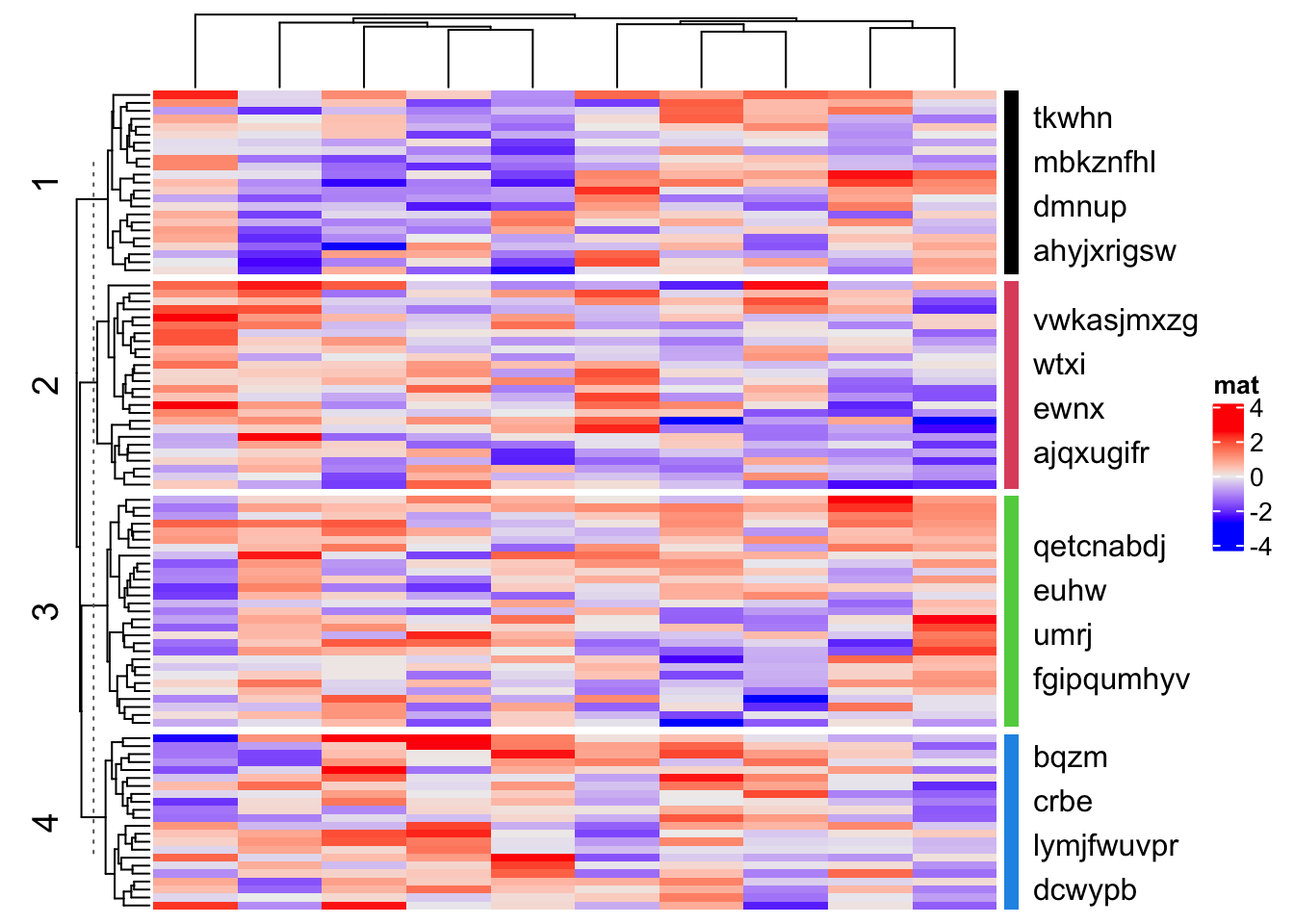
A second use of the empty annotation is to add complex annotation graphics
where the empty annotation pretends to be a virtual plotting region. You can
construct an annotation function by AnnotationFunction class for complex
annotation graphics, which allows subsetting and splitting, but still, it can
be a secondary choice to directly draw inside the empty annotation, which is
easier and faster for implementing (but less flexible and does not allow
splitting).
In following we show how to add a “complex version” of points annotation. The only thing that needs to be careful is the location on x-axis (y-axis if it is a row annotation) should correspond to the column index after column reordering.
ha = HeatmapAnnotation(foo = anno_empty(border = TRUE, height = unit(3, "cm")))
ht = Heatmap(matrix(rnorm(100), nrow = 10), name = "mat", top_annotation = ha)
ht = draw(ht)
co = column_order(ht)
value = runif(10)
decorate_annotation("foo", {
# value on x-axis is always 1:ncol(mat)
x = 1:10
# while values on y-axis is the value after column reordering
value = value[co]
pushViewport(viewport(xscale = c(0.5, 10.5), yscale = c(0, 1)))
grid.lines(c(0.5, 10.5), c(0.5, 0.5), gp = gpar(lty = 2),
default.units = "native")
grid.points(x, value, pch = 16, size = unit(2, "mm"),
gp = gpar(col = ifelse(value > 0.5, "red", "blue")), default.units = "native")
grid.yaxis(at = c(0, 0.5, 1))
popViewport()
})
3.4 Block annotation
The block annotation is more like a color block which identifies groups when the rows or columns of the heatmap are split.
Heatmap(matrix(rnorm(100), 10), name = "mat",
top_annotation = HeatmapAnnotation(foo = anno_block(gp = gpar(fill = 2:4))),
column_km = 3)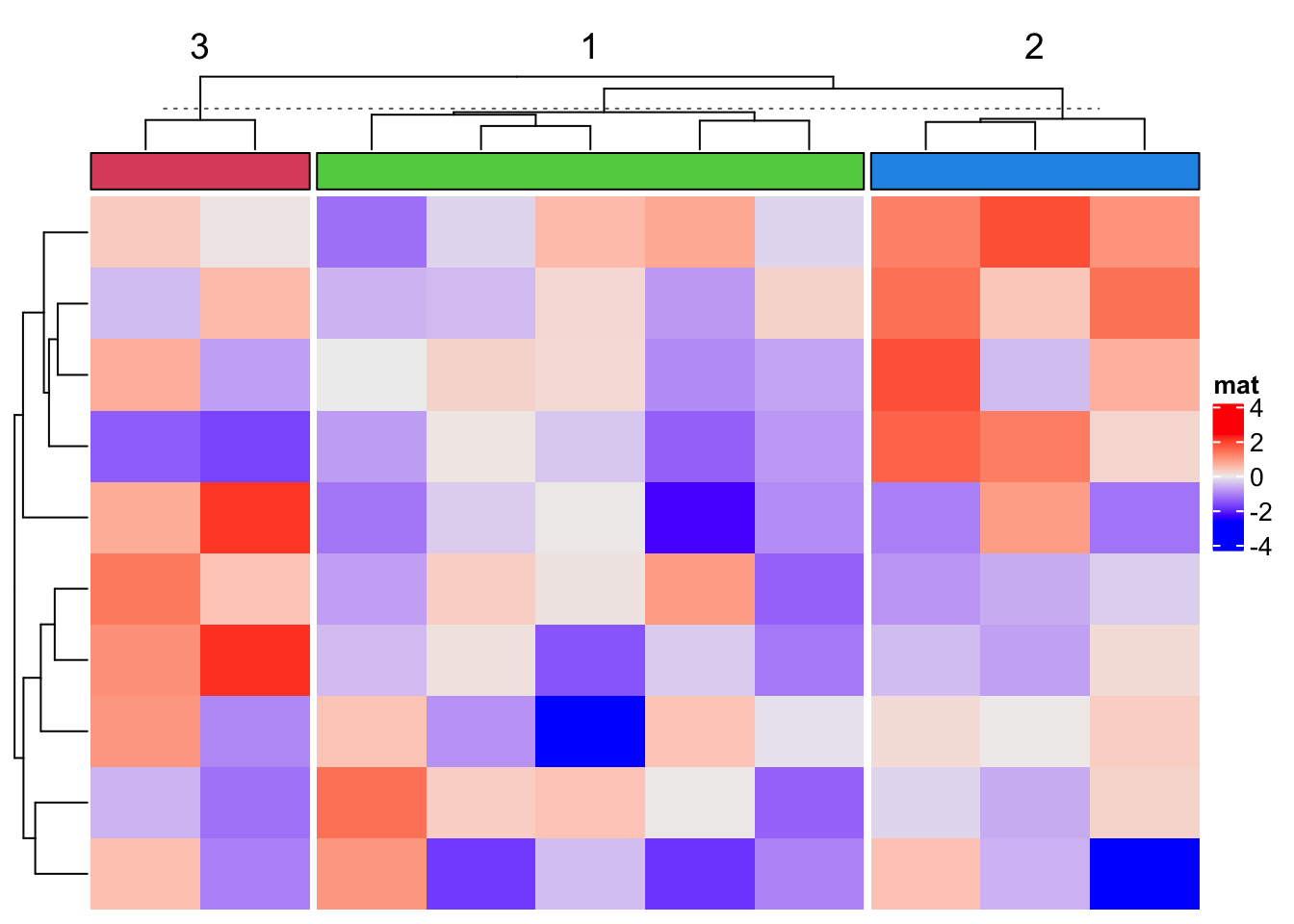
Labels can be added to each block.
Heatmap(matrix(rnorm(100), 10),
top_annotation = HeatmapAnnotation(foo = anno_block(gp = gpar(fill = 2:4),
labels = c("group1", "group2", "group3"),
labels_gp = gpar(col = "white", fontsize = 10))),
column_km = 3,
left_annotation = rowAnnotation(foo = anno_block(gp = gpar(fill = 2:4),
labels = c("group1", "group2", "group3"),
labels_gp = gpar(col = "white", fontsize = 10))),
row_km = 3)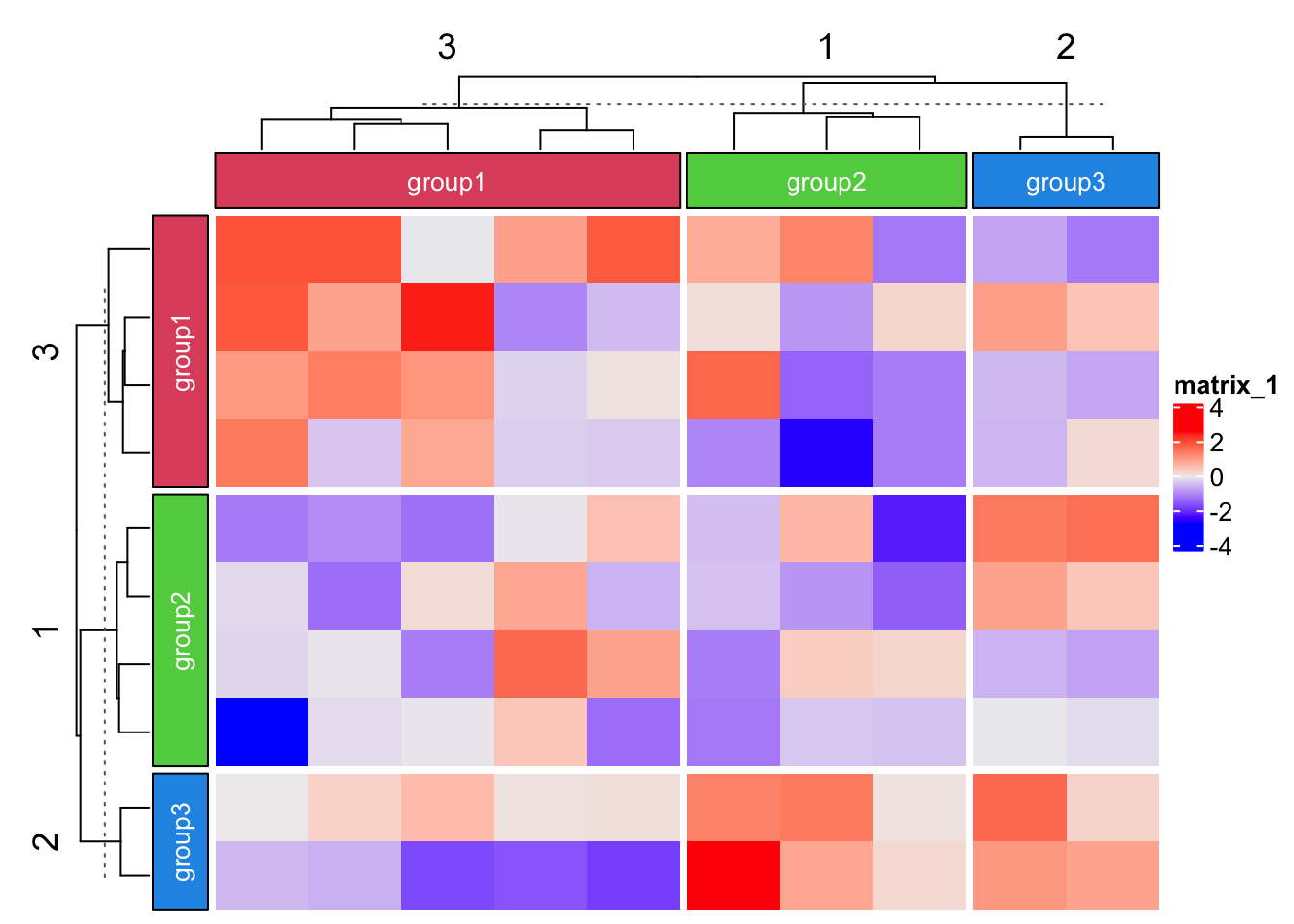
Note the length of labels or graphic parameters should have the same length
as the number of slices.
3.5 Image annotation
Images can be added as annotations. anno_image() supports image in png,
svg, pdf, eps, jpeg/jpg, tiff formats. How they are imported as
annotations are as follows:
png,jpeg/jpgandtiffimages are imported bypng::readPNG(),jpeg::readJPEG()andtiff::readTIFF(), and drawn bygrid::grid.raster().svgimages are firstly reformatted byrsvg::rsvg_svg()and then imported bygrImport2::readPicture()and drawn bygrImport2::grid.picture().pdfandepsimages are imported bygrImport::PostScriptTrace()andgrImport::readPicture(), later drawn bygrImport::grid.picture().
The free icons for following examples are from
https://github.com/Keyamoon/IcoMoon-Free. A vector of image paths are set as
the first argument of anno_image().
image_png = sample(dir("IcoMoon-Free-master/PNG/64px", full.names = TRUE), 10)
image_svg = sample(dir("IcoMoon-Free-master/SVG/", full.names = TRUE), 10)
image_eps = sample(dir("IcoMoon-Free-master/EPS/", full.names = TRUE), 10)
image_pdf = sample(dir("IcoMoon-Free-master/PDF/", full.names = TRUE), 10)
# we only draw the image annotation for PNG images, while the others are the same
ha = HeatmapAnnotation(foo = anno_image(image_png))
Different image formats can be mixed in the input vector.
# code only for demonstration
ha = HeatmapAnnotation(foo = anno_image(c(image_png[1:3], image_svg[1:3],
image_eps[1:3], image_pdf[1:3])))Border and background colors (if the images have transparent background) can
be set by gp.

border controls the border of the whole annotation.
Padding or space around the images is set by space.

If only some of the images need to be drawn, the other elements in the image
vector can be set to '' or NA.

3.6 Points annotation
Points annotation implemented as anno_points() shows distribution of a list
of data points. The data points object x can be a single vector or a matrix.
If it is a matrix, the graphic settings such as pch, size and gp can
correpspond to matrix columns. Note again, if x is a matrix, rows in x
correspond to columns in the heatmap matrix.

ha = HeatmapAnnotation(foo = anno_points(matrix(runif(20), nc = 2),
pch = 1:2, gp = gpar(col = 2:3)))
ylim controls the range on “y-axis” or the “data axis” (if it is a row
annotation, the data axis is horizontal), extend controls the extended space
on the data axis direction. axis controls whether to show the axis and
axis_param controls the settings for axis. The default settings for axis are:
## $at
## NULL
##
## $labels
## NULL
##
## $labels_rot
## [1] 0
##
## $gp
## $fontsize
## [1] 8
##
##
## $side
## [1] "left"
##
## $facing
## [1] "outside"
##
## $direction
## [1] "normal"And you can overwrite some of them:
ha = HeatmapAnnotation(foo = anno_points(runif(10), ylim = c(0, 1),
axis_param = list(
side = "right",
at = c(0, 0.5, 1),
labels = c("zero", "half", "one")
))
)
One thing that might be useful is you can control the rotation of the axis labels.
ha = rowAnnotation(foo = anno_points(runif(10), ylim = c(0, 1),
width = unit(2, "cm"),
axis_param = list(
side = "bottom",
at = c(0, 0.5, 1),
labels = c("zero", "half", "one"),
labels_rot = 45
))
)
The configuration of axis is same for other annotation functions which have axes.
The default size of the points annotation is 5mm. It can be controlled by
height/width argument in anno_points().
3.7 Lines annotation
anno_lines() connects the data points by a list of segments. Similar as
anno_points(), the data variable can be a numeric vector:

Or a matrix:
ha = HeatmapAnnotation(foo = anno_lines(cbind(c(1:5, 1:5), c(5:1, 5:1)),
gp = gpar(col = 2:3), add_points = TRUE, pt_gp = gpar(col = 5:6), pch = c(1, 16)))
As shown above, points can be added to the lines by setting add_points = TRUE.
Smoothed lines (by loess()) can be added instead of the original lines by
setting smooth = TRUE, but it should be used with caution because the order of
columns in the heatmap is used as “x-value” for the fitting and only if you think
the fitting against the reordered order makes sense.
Smoothing also works when the input data variable is a matrix that the smoothing is performed for each column separately.
If smooth is TRUE, add_points is set to TRUE by default.

The default size of the lines annotation is 5mm. It can be controlled by
height/width argument in anno_lines().
3.8 Barplot annotation
The data points can be represented as barplots. Some of the arguments in
anno_barplot() such as ylim, axis, axis_param are the same as
anno_points().

The width of bars is controlled by bar_width. It is a relative value to the
width of the cell in the heatmap.

Graphic parameters are controlled by gp.

You can choose the baseline of bars by baseline.


If the input value is a matrix, it will be stacked barplots.

And length of parameters in gp can be the number of the columns in the matrix:

The default size of the barplot annotation is 5mm. It can be controlled by
height/width argument in anno_barplot().
# code only for demonstration
ha = HeatmapAnnotation(foo = anno_barplot(runif(10), height = unit(2, "cm")))Following example shows a barplot annotation which visualizes a proportion matrix (for which row sums are 1).
m = matrix(runif(4*10), nc = 4)
m = t(apply(m, 1, function(x) x/sum(x)))
ha = HeatmapAnnotation(foo = anno_barplot(m, gp = gpar(fill = 2:5),
bar_width = 1, height = unit(6, "cm")))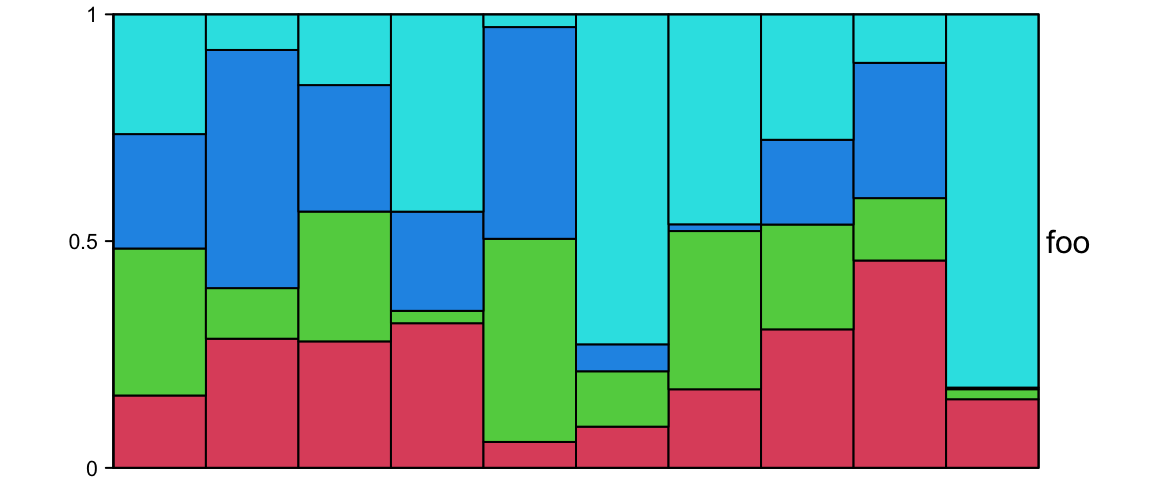
The direction of the axis can be reversed which is useful when the annotation is put on the left of the heatmap.
ha_list = rowAnnotation(axis_reverse = anno_barplot(m, gp = gpar(fill = 2:5),
axis_param = list(direction = "reverse"),
bar_width = 1, width = unit(4, "cm"))) +
rowAnnotation(axis_normal = anno_barplot(m, gp = gpar(fill = 2:5),
bar_width = 1, width = unit(4, "cm")))
draw(ha_list, ht_gap = unit(4, "mm"))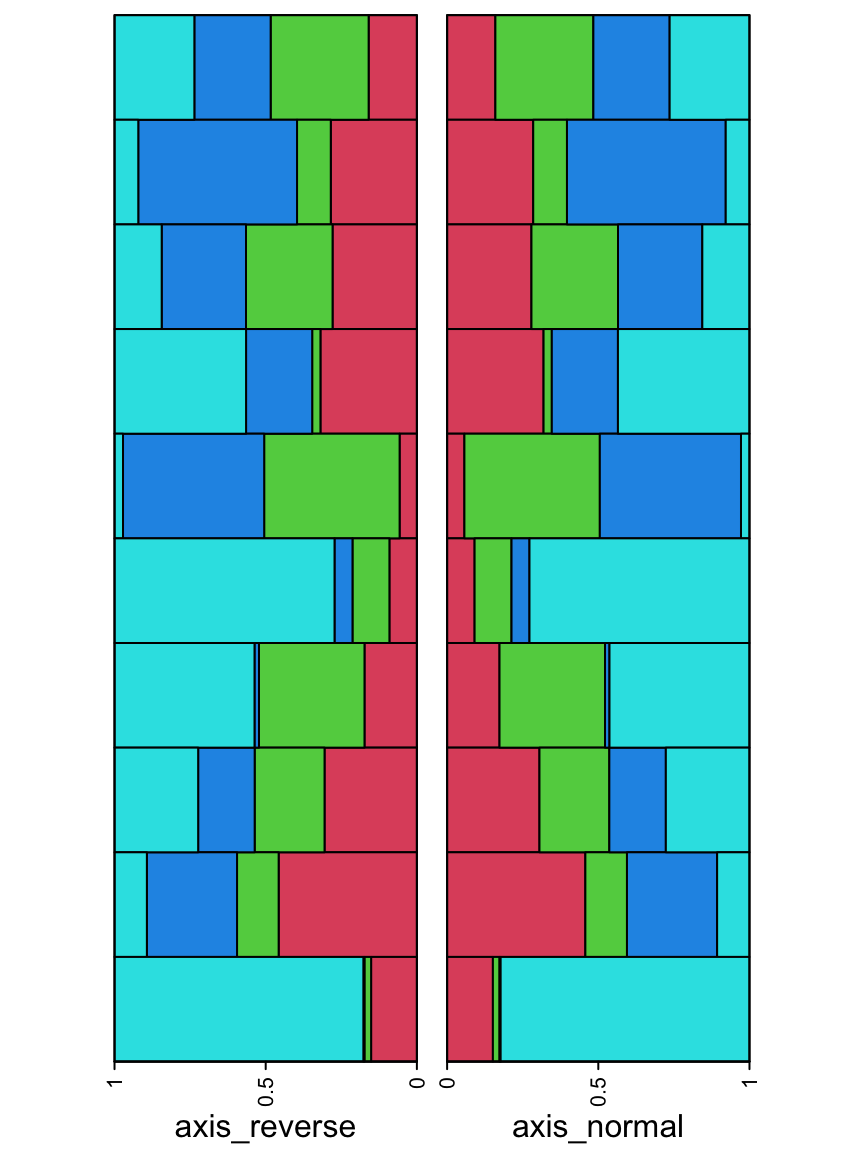
direction = "reverse" also works for other annotation functions which have
axes, but it is more commonly used for barplot annotations.
3.9 Boxplot annotation
Boxplot annotation as well as the annotation functions which are introduced later are more suitable for small matrice. I don’t think you want to put boxplots as column annotation for a matrix with 100 columns.
For anno_boxplot(), the input data variable should be a matrix or a list. If
x is a matrix and if it is a column annotation, statistics for boxplots are
calculated by columns, and if it is a row annotation, the calculation is done
by rows.
set.seed(12345)
m = matrix(rnorm(100), 10)
ha = HeatmapAnnotation(foo = anno_boxplot(m, height = unit(4, "cm")))
Graphic parameters are controlled by gp.

Width of the boxes are controlled by box_width. outline controls whether to
show outlier points.
ha = HeatmapAnnotation(foo = anno_boxplot(m, height = unit(4, "cm"),
box_width = 0.9, outline = FALSE))
anno_boxplot() only draws one boxplot for one single row. Section
9.6 demonstrates how to define an annotation function which
draws multiple boxplots for a single row, and Section 3.17
demonstrates how to draw one single boxplot for a group of rows.
3.10 Histogram annotation
Annotations as histograms are more suitable to put as row annotations. The
setting for the data variable is the same as anno_boxplot() which can be a
matrix or a list.
Similar as anno_boxplot(), the input data variable should be a matrix or a list. If
x is a matrix and if it is a column annotation, histograms are
calculated by columns, and if it is a row annotation, histograms are calculated
by rows.

Number of breaks for histograms is controlled by n_breaks.

Colors are controlled by gp.

3.11 Density annotation
Similar as histogram annotations, anno_density() shows the distribution
as a fitted curve.

The height of the density peaks can be controlled to make the distribution look like a “joyplot”.

Or visualize the distribution as violin plot.

When there are too many rows in the input variable, the space for normal density peaks might be too small. In this case, we can visualize the distribution by heatmaps.
m2 = matrix(rnorm(50*10), nrow = 50)
ha = rowAnnotation(foo = anno_density(m2, type = "heatmap", width = unit(6, "cm")))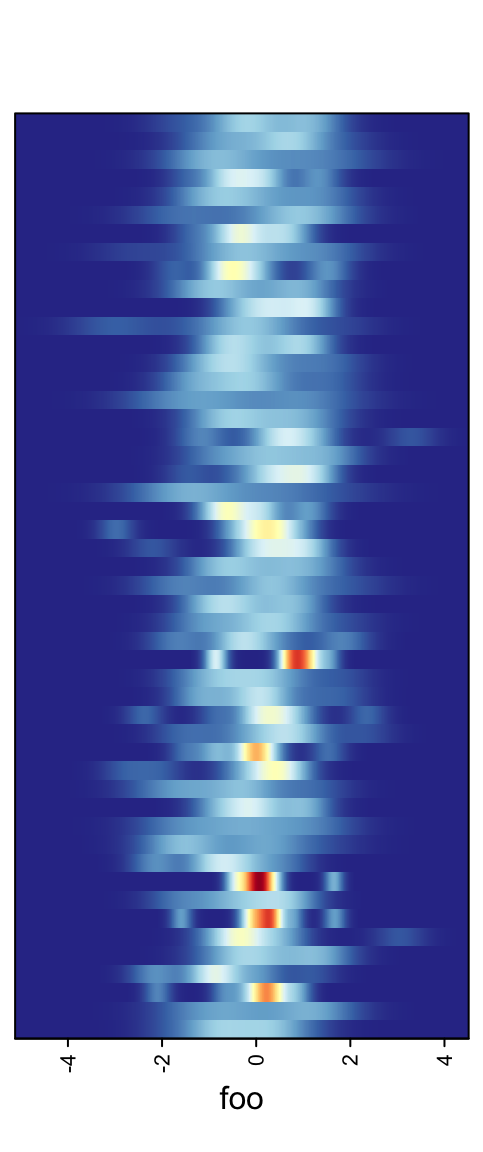
THe color schema for heatmap distribution is controlled by heatmap_colors.
ha = rowAnnotation(foo = anno_density(m2, type = "heatmap", width = unit(6, "cm"),
heatmap_colors = c("white", "orange")))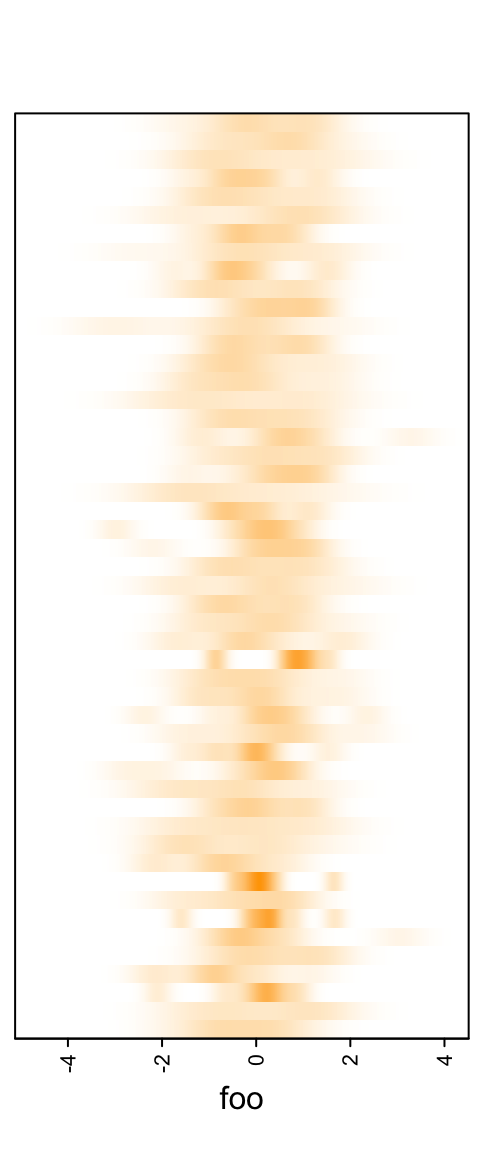
In ComplexHeatmap package, there is a densityHeatmap() function which
visualizes distribution as a heatmap. It will be introduced in Section
10.1.
3.12 Joyplot annotation
anno_joyplot() is specific for so-called joyplot (http://blog.revolutionanalytics.com/2017/07/joyplots.html).
The input data should be a matrix or a list.
Note anno_joyplot() is always applied to columns if the input is a matrix.
Because joyplot visualizes parallel distributions and the matrix is not a
necessary format while a list is already enough for it, if you are not sure
about how to set as a matrix, just convert it to a list for using it.
m = matrix(rnorm(1000), nc = 10)
lt = apply(m, 2, function(x) data.frame(density(x)[c("x", "y")]))
ha = rowAnnotation(foo = anno_joyplot(lt, width = unit(4, "cm"),
gp = gpar(fill = 1:10), transparency = 0.75))
Or only show the lines (scale argument controls the relative height of the
curves).
m = matrix(rnorm(5000), nc = 50)
lt = apply(m, 2, function(x) data.frame(density(x)[c("x", "y")]))
ha = rowAnnotation(foo = anno_joyplot(lt, width = unit(4, "cm"), gp = gpar(fill = NA),
scale = 4))
The format of the input variable is special. It can be one of the following two:
- a matrix (remember
anno_joyplot()is always applied to columns of the matrix) where x coordinate corresponds to1:nrow(matrix)and each column in the matrix corresponds to one distribution in the joyplot. - a list of data frames where each data frame has two columns which correspond to x coordinate and y coordinate.
3.13 Horizon chart annotation
Horizon
chart
as annotation can only be added as row annotation. The format of the input
variable for anno_horizon() is the same as anno_joyplot() which is
introduced in previous section.
The default style of horizon chart annotation is:
lt = lapply(1:20, function(x) cumprod(1 + runif(1000, -x/100, x/100)) - 1)
ha = rowAnnotation(foo = anno_horizon(lt))
Values in each track are normalized by x/max(abs(x)).
Colors for positive values and negative values are controlled by pos_fill
and neg_fill in gpar().

pos_fill and neg_fill can be assigned as a vector.
ha = rowAnnotation(foo = anno_horizon(lt,
gp = gpar(pos_fill = rep(c("orange", "red"), each = 10),
neg_fill = rep(c("darkgreen", "blue"), each = 10))))
Whether the peaks for negative values start from the bottom or from the top.

The space between every two neighbouring charts.

3.14 Text annotation
Text can be used as annotations by anno_text(). Graphic parameters are controlled
by gp.

Locationsn are controlled by location and just. Rotation is controlled by rot.
ha = rowAnnotation(foo = anno_text(month.name, location = 1, rot = 30,
just = "right", gp = gpar(fontsize = 1:12+4)))

location and just are automatically calculated according the the position
of the annotations put to the heatmap (e.g. text are aligned to the left if it
is a right annotation to the heatmap and are aligned to the right it it is a
left annotation).
The width/height are automatically calculated based on all the text. Normally you don’t need to manually set the width/height of it.
Background colors can be set by gp. Here fill controls the filled
background color, col controls the color of text and the non-standard
border controls the background border color.
You can see we explicitly set width as 1.2 times the width of the longest
text.
ha = rowAnnotation(foo = anno_text(month.name, location = 0.5, just = "center",
gp = gpar(fill = rep(2:4, each = 4), col = "white", border = "black"),
width = max_text_width(month.name)*1.2))
3.15 Mark annotation
Sometimes there are many rows or columns in the heatmap and we want to mark
some of them. anno_mark() is used to mark subset of rows or columns and
connect to labels with lines.
anno_mark() at least needs two arguments where at are the indices to the
original matrix and labels are the corresponding text.
m = matrix(rnorm(1000), nrow = 100)
ha = rowAnnotation(foo = anno_mark(at = c(1:4, 20, 60, 97:100), labels = month.name[1:10]))
Heatmap(m, name = "mat", cluster_rows = FALSE, right_annotation = ha)
3.16 Summary annotation
There is one special annotation anno_summary() which only works with
one-column heatmap or one-row heatmap (we can say the heatmap only contains a
vector). It shows summary statistics for the vector in the heatmap. If the
corresponding vector is discrete, the summary annotation is presented as
barplots and if the vector is continuous, the summary annotation is boxplot.
anno_summary() is always used when the heatmap is split so that statistics
can be compared between heatmap slices.
The first example shows the summary annotation for discrete heatmap. The barplot shows the proportion of each level in each slice. The absolute values can already be seen by the height of the heatmap slice.
The color schema for the barplots is automatically extracted from the heatmap.
ha = HeatmapAnnotation(summary = anno_summary(height = unit(4, "cm")))
v = sample(letters[1:2], 50, replace = TRUE)
split = sample(letters[1:2], 50, replace = TRUE)
Heatmap(v, name = "mat", col = c("a" = "red", "b" = "blue"),
top_annotation = ha, width = unit(2, "cm"), row_split = split)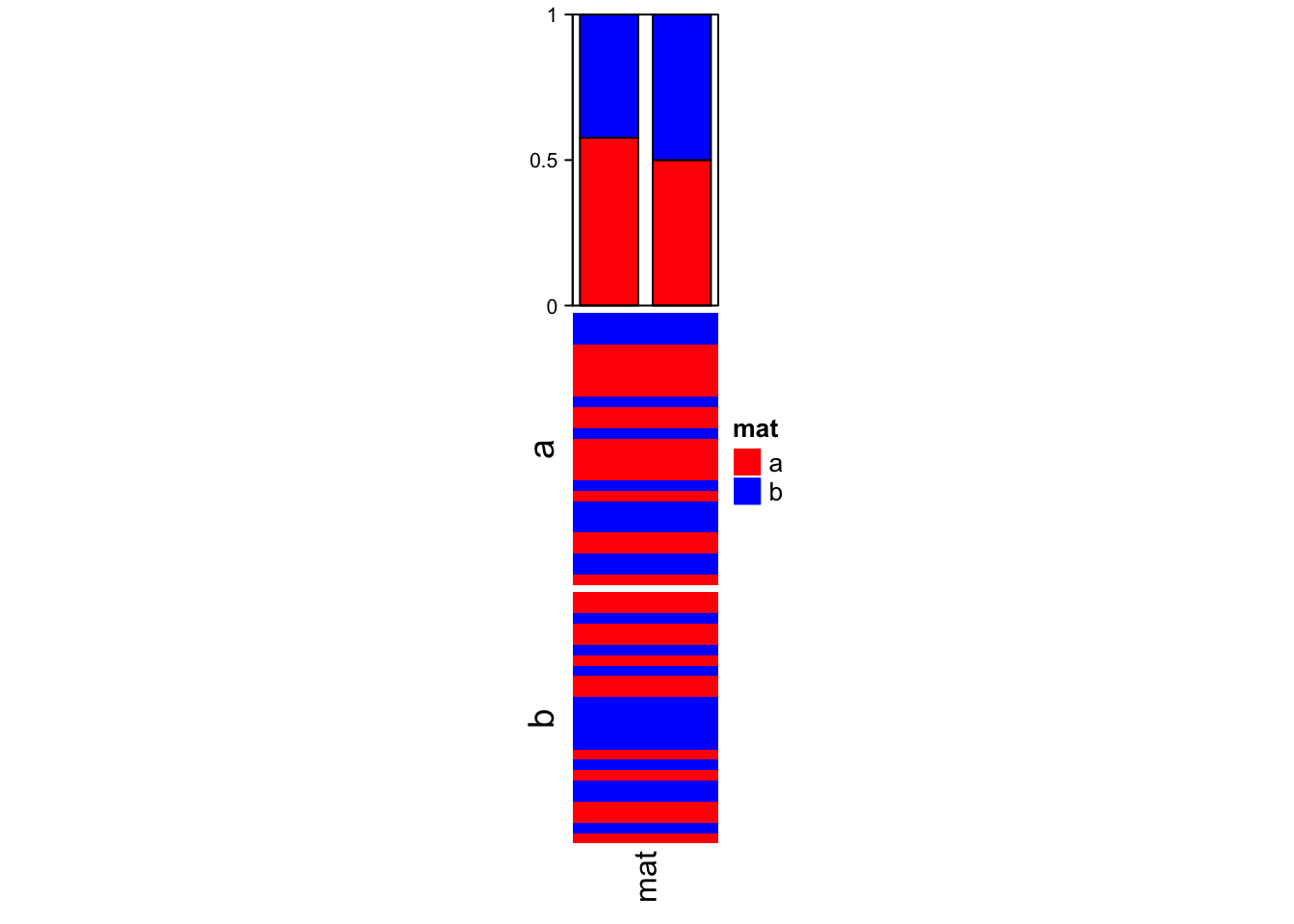
The second example shows the summary annotation for continuous heatmap. The
graphic parameters should be manually set by gp. The legend of the boxplot
can be created and added as introduced in Section 5.2,
last second paragraph.
ha = HeatmapAnnotation(summary = anno_summary(gp = gpar(fill = 2:3),
height = unit(4, "cm")))
v = rnorm(50)
Heatmap(v, name = "mat", top_annotation = ha, width = unit(2, "cm"),
row_split = split)
Normally we don’t draw this one-column heatmap along. It is always combined with other “main heatmaps”. E.g. A gene expression matrix with a one-column heatmap which shows whether the gene is a protein coding gene or a linc-RNA gene.
In following, we show a simple example of a “main heatmap” with two one-column heatmaps. The functionality of heatmap concatenation will be introduced in Chapter 4.
m = matrix(rnorm(50*10), nrow = 50)
ht_list = Heatmap(m, name = "main_matrix")
ha = HeatmapAnnotation(summary = anno_summary(height = unit(3, "cm")))
v = sample(letters[1:2], 50, replace = TRUE)
ht_list = ht_list + Heatmap(v, name = "mat1", top_annotation = ha, width = unit(1, "cm"))
ha = HeatmapAnnotation(summary = anno_summary(gp = gpar(fill = 2:3),
height = unit(3, "cm")))
v = rnorm(50)
ht_list = ht_list + Heatmap(v, name = "mat2", top_annotation = ha, width = unit(1, "cm"))
split = sample(letters[1:2], 50, replace = TRUE)
lgd_boxplot = Legend(labels = c("group a", "group b"), title = "group",
legend_gp = gpar(fill = c("red", "blue")))
draw(ht_list, row_split = split, ht_gap = unit(5, "mm"),
heatmap_legend_list = list(lgd_boxplot))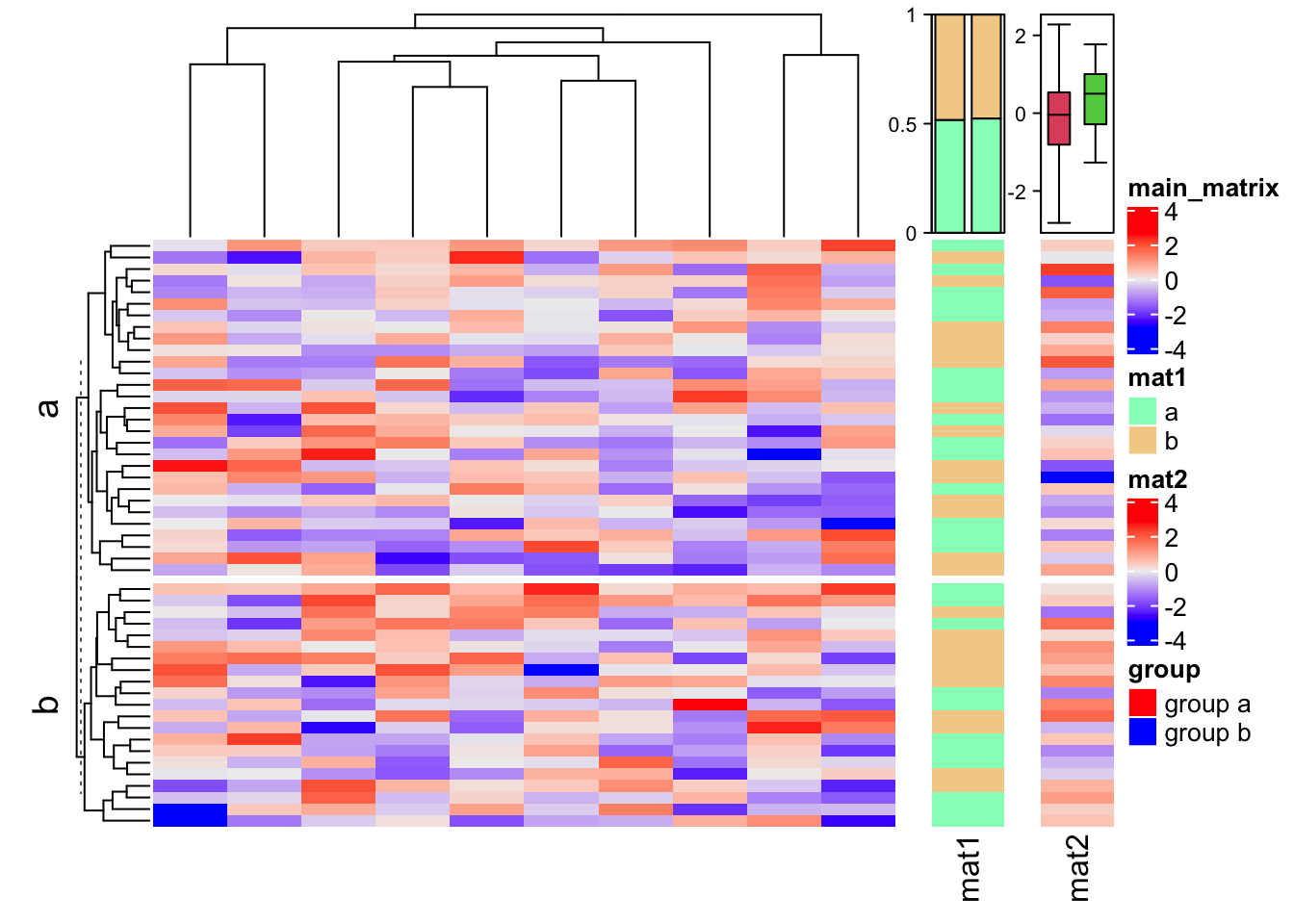
3.17 Zoom/link annotation
It is very common scenario that we want to annotate subsets of rows/columns in
the heatmap. anno_zoom() helps to create plotting regions that correspond to
the original subsets of rows/columns in the heatmap. Since the height/width
are usually different from that from the orignal subsets in the heatmap, these
plotting regions created by anno_zoom() can be thought as “zoomings” of the
original heatmap.
Let’s see following example where we make boxplot for each row group.
set.seed(123)
m = matrix(rnorm(100*10), nrow = 100)
subgroup = sample(letters[1:3], 100, replace = TRUE, prob = c(1, 5, 10))
rg = range(m)
panel_fun = function(index, nm) {
pushViewport(viewport(xscale = rg, yscale = c(0, 2)))
grid.rect()
grid.xaxis(gp = gpar(fontsize = 8))
grid.boxplot(m[index, ], pos = 1, direction = "horizontal")
popViewport()
}
anno = anno_zoom(align_to = subgroup, which = "row", panel_fun = panel_fun,
size = unit(2, "cm"), gap = unit(1, "cm"), width = unit(4, "cm"))
Heatmap(m, name = "mat", right_annotation = rowAnnotation(foo = anno), row_split = subgroup)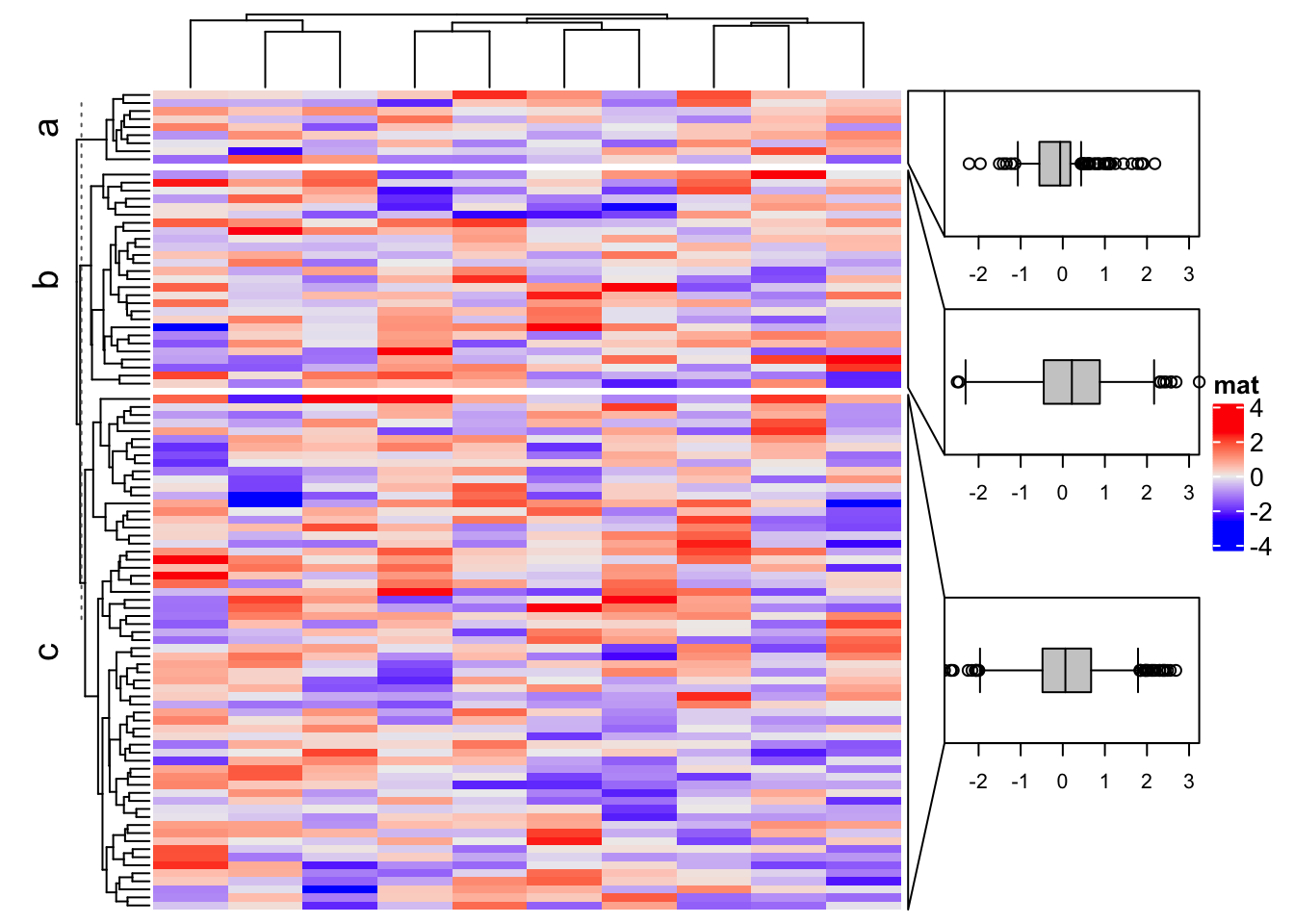
The important arguments for anno_zoom() are:
align_to: It defines how the plotting regions (or the boxes) correspond to the rows or the columns in the heatmap. If the value is a list of indices, each box corresponds to the rows or columns with indices in one vector in the list. If the value is a categorical variable (e.g. a factor or a character vector) that has the same length as the rows or columns in the heatmap, each box corresponds to the rows/columns in each level in the categorical variable.panel_fun: A self-defined function that defines how to draw graphics in the box. The function must have aindexargument which is the indices for the rows/columns that the box corresponds to. It can have a second argumentnmwhich is the “name” of the selected part in the heatmap. The corresponding value fornmcomes fromalign_toif it is specified as a categorical variable or a list with names.size: The size of boxes. It can be pure numeric that they are treated as relative fractions of the total height/width of the heatmap. The value ofsizecan also be absolute units.gap: Gaps between boxes. It should be aunitobject.
anno_zoom() also works for column annotations.
In previous example, box plots in the “zoom annotation” use the same data as in the
heatmap (they share using the same values in the matrix). In some other cases, the annotations
do not have very strong relations to the matrix, except the information of which
rows from the matrix. In this case, the functionality is more proper
to be understanded as to provide linking between subsets of rows and
a list of graphic regions. Thus, there is an anno_link() function which is basically the same as anno_zoom().
The two functions are exactly the same, just with different names, depends
how you understand. An example of using anno_link() is to correspond a list of text to a
subset of rows, see examples from https://github.com/jokergoo/simplifyEnrichment.

3.18 Multiple annotations
As mentioned before, to put multiple annotations in HeatmapAnnotation(),
they just need to be specified as name-value pairs. In HeatmapAnnotation(),
there are some arguments which controls multiple annotations. For these
arguments, they are specified as a vector which has same length as number of
the annotations, or a named vector with subset of the annotations.
The simple annotations which are specified as vectors, matrices and data
frames will automatically have legends on the heatmap. show_legend controls
whether to draw the legends for them. Note here if show_legend is a vector,
the value of show_legend should be in one of the following formats:
- A logical vector with the same length as the number of simple annotations.
- A logical vector with the same length as the number of totla annotations. The values for complex annotations are ignored.
- A named vector to control subset of the simple annotations.
For customization on the annotation legends, please refer to Section 5.4.
ha = HeatmapAnnotation(foo = 1:10,
bar = cbind(1:10, 10:1),
pt = anno_points(1:10),
show_legend = c("bar" = FALSE)
)
Heatmap(matrix(rnorm(100), 10), name = "mat", top_annotation = ha)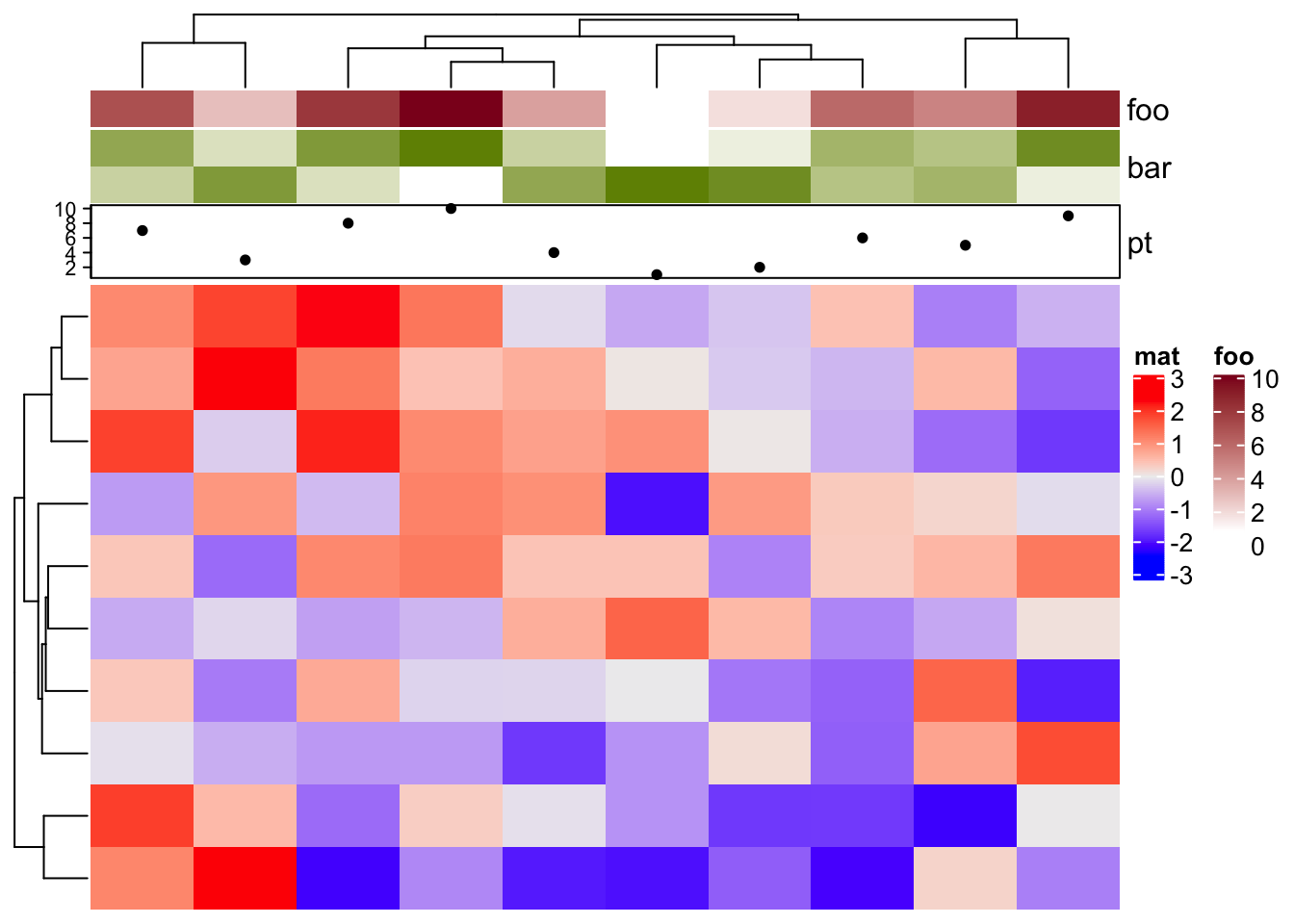
gp controls graphic parameters (except fill) for the simple annotatios,
such as the border of annotation grids.
ha = HeatmapAnnotation(foo = 1:10,
bar = cbind(1:10, 10:1),
pt = anno_points(1:10),
gp = gpar(col = "red")
)
border controls the border of every single annotations.
show_annotation_name controls whether show annotation names. As mentioned,
the value can be a single value, a vector or a named vector.
ha = HeatmapAnnotation(foo = 1:10,
bar = cbind(1:10, 10:1),
pt = anno_points(1:10),
show_annotation_name = c(bar = FALSE), # only turn off `bar`
border = c(foo = TRUE) # turn on foo
)
annotation_name_gp, annotation_name_offset, annotation_name_side and
annotation_name_rot control the style and position of the annotation names.
The latter three can be specified as named vectors. If
annotation_name_offset is specified as a named vector, it can be specified
as characters while not unit objects: annotation_name_offset = c(foo = "1cm").
gap controls the space between every two neighbouring annotations. The value
can be a single unit or a vector of units.
ha = HeatmapAnnotation(foo = 1:10,
bar = cbind(1:10, 10:1),
pt = anno_points(1:10),
gap = unit(2, "mm"))
ha = HeatmapAnnotation(foo = 1:10,
bar = cbind(1:10, 10:1),
pt = anno_points(1:10),
gap = unit(c(2, 10), "mm"))
3.18.1 Size of annotations
height, width, annotation_height and annotation_width control the
height or width of the complete heatmap annotations. Normally you don’t need
to set them because all the single annotations have fixed height/width and the
final height/width for the whole heatmap annotation is the sum of them.
Resizing these values will involve rather complicated adjustment depending on
whether it is a simple annotation or complex annotation. The resizing of
heatmap annotations will also happen when adjusting a list of heatmaps. In
following examples, we take column annotations as examples and demonstrate
some scenarios for the resizing adjustment.
First the default height of ha:
# foo: 1cm, bar: 5mm, pt: 1cm
ha = HeatmapAnnotation(foo = cbind(1:10, 10:1),
bar = 1:10,
pt = anno_points(1:10))
If height is set, the size of the simple annotation will not change, while
only the complex annotations are adjusted. If there are multiple complex
annotations, they are adjusted according to the ratio of their original size.
# foo: 1cm, bar: 5mm, pt: 4.5cm
ha = HeatmapAnnotation(foo = cbind(1:10, 10:1),
bar = 1:10,
pt = anno_points(1:10),
height = unit(6, "cm"))
simple_anno_size controls the height of all simple annotations. Recall
ht_opt$simple_anno_size can be set to globally control the size of simple
annotations in all heatmaps.
# foo: 2cm, bar:1cm, pt: 3cm
ha = HeatmapAnnotation(foo = cbind(1:10, 10:1),
bar = 1:10,
pt = anno_points(1:10),
simple_anno_size = unit(1, "cm"), height = unit(6, "cm"))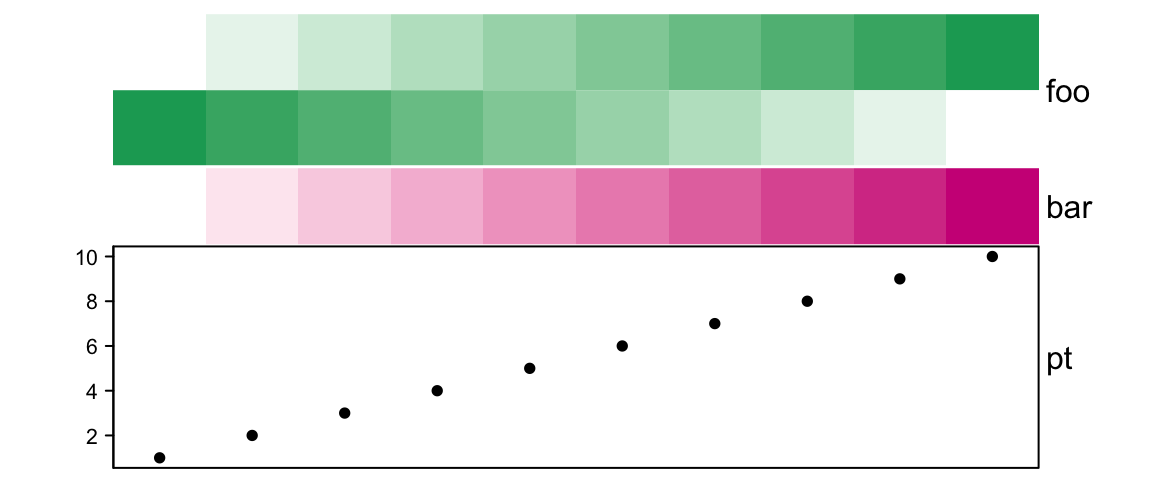
If annotation_height is set as a vector of absolute units, the height of all
three annotations are adjusted accordingly.
# foo: 1cm, bar: 2cm, pt: 3cm
ha = HeatmapAnnotation(foo = cbind(1:10, 10:1),
bar = 1:10,
pt = anno_points(1:10),
annotation_height = unit(1:3, "cm"))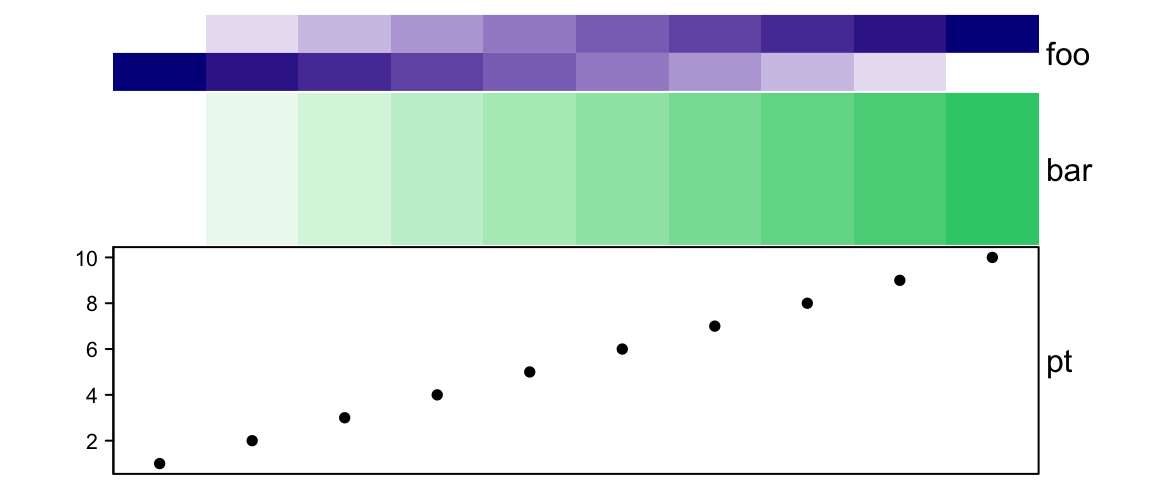
If annotation_height is set as pure numbers which is treated as relative
ratios for annotations, height should also be set as an absolute unit and
the size of every single annotation is adjusted by the ratios.
# foo: 1cm, bar: 2cm, pt: 3cm
ha = HeatmapAnnotation(foo = cbind(1:10, 10:1),
bar = 1:10,
pt = anno_points(1:10),
annotation_height = 1:3, height = unit(6, "cm"))
annotation_height can be mixed with relative units (in null unit) and
absolute units.
# foo: 1.5cm, bar: 1.5cm, pt: 3cm
ha = HeatmapAnnotation(foo = cbind(1:10, 10:1),
bar = 1:10,
pt = anno_points(1:10),
annotation_height = unit(c(1, 1, 3), c("null", "null", "cm")), height = unit(6, "cm")
)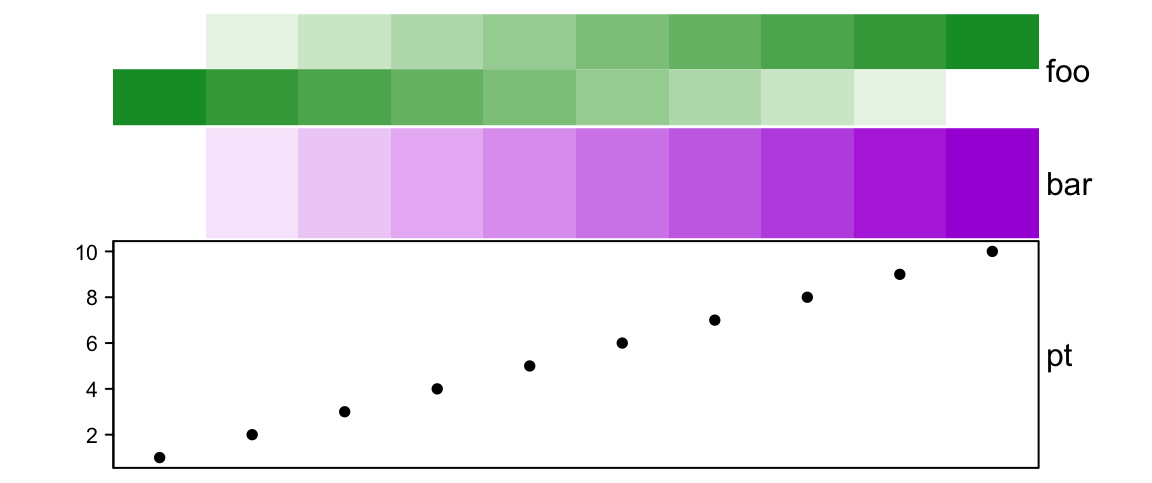
# foo: 2cm, bar: 1cm, pt: 3cm
ha = HeatmapAnnotation(foo = cbind(1:10, 10:1),
bar = 1:10,
pt = anno_points(1:10),
annotation_height = unit(c(2, 1, 3), c("cm", "null", "cm")), height = unit(6, "cm")
)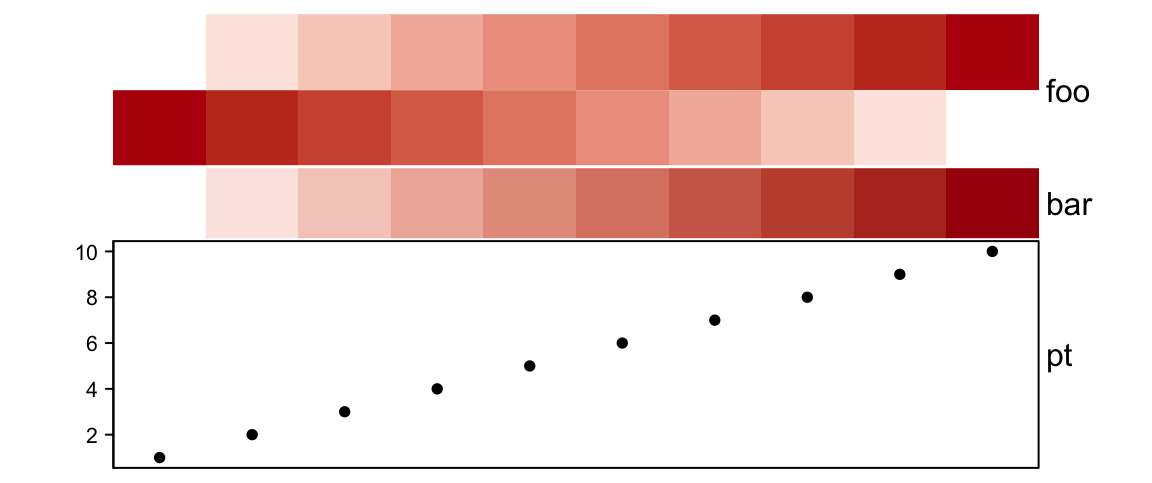
If there are only simple annotations, simply setting height won’t change the
height.
# foo: 1cm, bar: 5mm
ha = HeatmapAnnotation(foo = cbind(1:10, 10:1),
bar = 1:10,
height = unit(6, "cm"))
unless simple_anno_size_adjust is set to TRUE.
# foo: 4cm, bar: 2cm
ha = HeatmapAnnotation(foo = cbind(1:10, 10:1),
bar = 1:10,
height = unit(6, "cm"),
simple_anno_size_adjust = TRUE)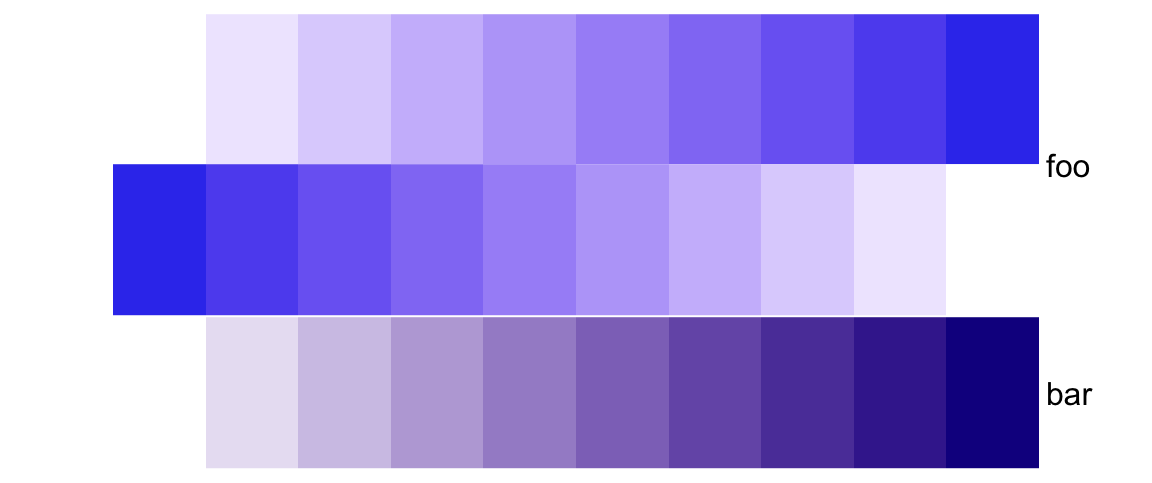
Section 4.6 introduces how the annotation sizes are adjusted among a list of heatmaps.
3.18.2 Annotation labels
From version 2.3.3, alternative labels for annotations can be set by annotation_label argument:
ha = HeatmapAnnotation(foo = 1:10,
bar = cbind(1:10, 10:1),
pt = anno_points(1:10),
annotation_label = c("Annotation_foo", "Annotation_bar", "Annotation_pt")
)
Heatmap(matrix(rnorm(100), 10), name = "mat", top_annotation = ha)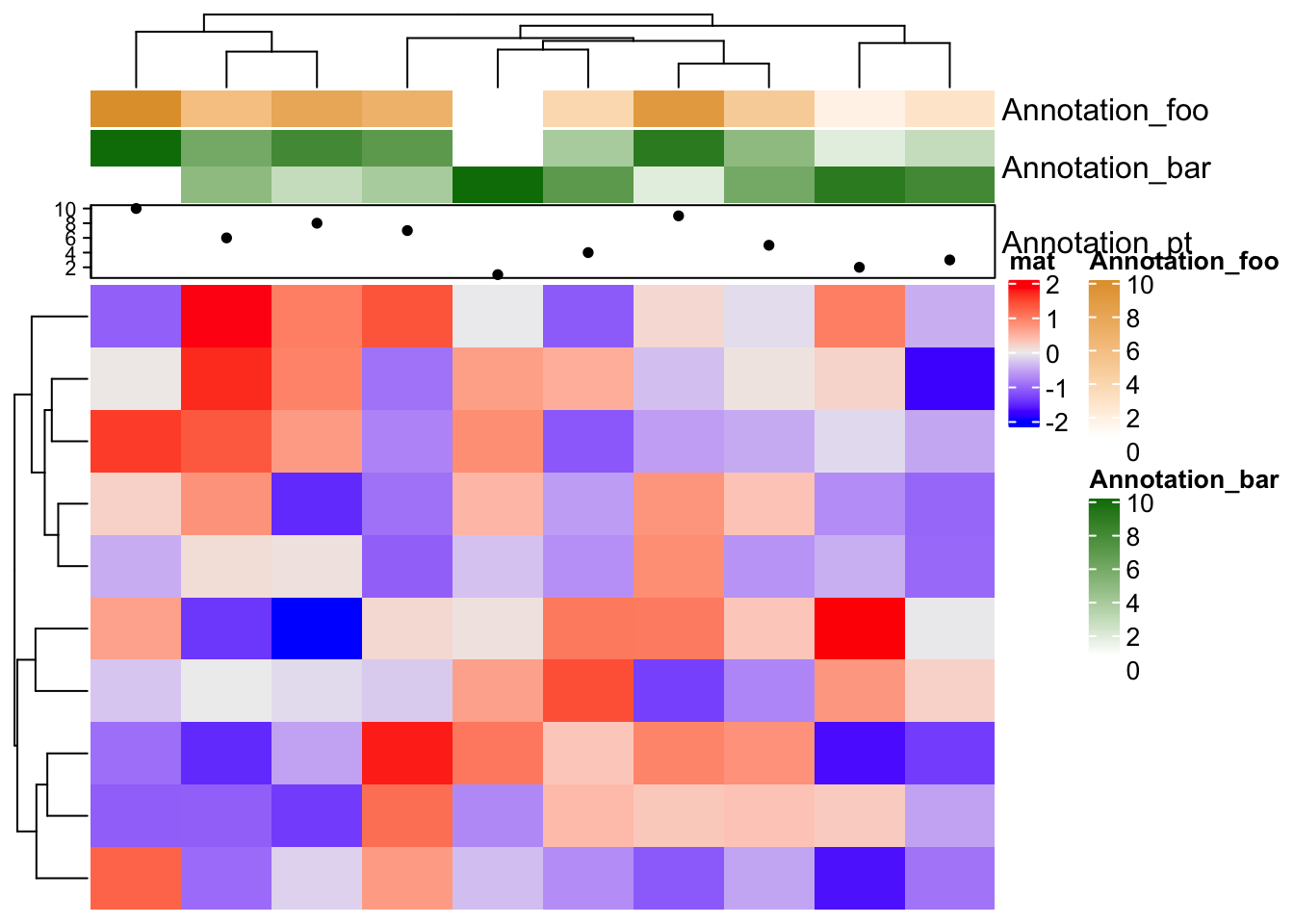
3.19 Utility functions
There are some utility functions which make the manipulation of heatmap annotation easier. Just see following examples.
## [1] 3## [1] 10Get or set the names of the annotations:
## [1] "foo" "bar" "pt"## [1] "FOO" "BAR" "PT"You can concatenate two HeatmapAnnotation objects if they contain same
number of observations and different annotation names.
ha1 = HeatmapAnnotation(foo = 1:10,
bar = cbind(1:10, 10:1),
pt = anno_points(1:10))
ha2 = HeatmapAnnotation(FOO = runif(10),
BAR = sample(c("a", "b"), 10, replace = TRUE),
PT = anno_points(rnorm(10)))
ha = c(ha1, ha2)
names(ha)## [1] "foo" "bar" "pt" "FOO" "BAR" "PT"
HeatmapAnnoation object sometimes is subsettable. The row index corresponds
to observations in the annotation and column index corresponds to the
annotations. If the annotations are all simple annotations or the complex
annotation created by anno_*() functions in ComplexHeatmap package, the
HeatmapAnnotation object is always subsettable.
## A HeatmapAnnotation object with 2 annotations
## name: heatmap_annotation_96
## position: column
## items: 5
## width: 1npc
## height: 15.3514598035146mm
## this object is subsetable
## 5.21733333333333mm extension on the left
## 6.75733333333333mm extension on the right
##
## name annotation_type color_mapping height
## foo continuous vector random 5mm
## PT anno_points() 10mm
3.20 Implement new annotation functions
All the annotation functions defined in ComplexHeatmap are constructed by
the AnnotationFunction class. The AnnotationFunction class not only stores
the “real R function” which draws the graphics, it also calculates the spaces
caused by the annotation axis, more importantly, it allows splitting the
annotation graphics according to the split of the main heatmap.
As expected, the main part of the AnnotationFunction class is a function
which defines how to draw at specific positions which correspond to rows or
columns in the heatmap. The function should have three arguments: index, k
and n (the names of the arguments can be arbitrary) where k and n are
optional. index corresponds to the indices of rows or columns of the
heatmap. The value of index is not necessarily to be the whole row indices
or column indices in the heatmap. It can also be a subset of the indices if
the annotation is split into slices according to the split of the heatmap.
index is reordered according to the reordering of heatmap rows or columns
(e.g. by clustering). So, index actually contains a list of row or column
indices for the current slice after row or column reordering.
As mentioned, annotation can be split into slices. k corresponds to the
current slice and n corresponds to the total number of slices. The
annotation function draws in every slice repeatedly. The information of k
and n sometimes can be useful, for example, we want to add axis in the
annotation, and if it is a column annotation and axis is drawn on the very
right of the annotation area, the axis is only drawn when k == n.
Since the function only allows index, k and n, the function sometimes
uses several external variables which can not be defined inside the function,
e.g. the data points for the annotation. These variables should be imported
into the AnnotationFunction class by var_import so that the function can
correctly find these variables.
One important feature for AnnotationFunction class is it can be subsetable,
which is the base for splitting. To allow subsetting of the object, users need
to define the rule for the imported variables if there is any. The rules are
simple functions which accpet the variable and indices, and return the subset
of the variable. The subset rule functions implemented in this package are
subset_gp(), subset_matrix_by_row() and subset_vector(). If the
subsetting rule is not provided, it is inferred by the type of the object.
We first construct an AnnotationFunction object which needs external
variable and supports subsetting.
x = 1:10
anno1 = AnnotationFunction(
fun = function(index, k, n) {
n = length(index)
pushViewport(viewport(xscale = c(0.5, n + 0.5), yscale = c(0, 10)))
grid.rect()
grid.points(1:n, x[index], default.units = "native")
if(k == 1) grid.yaxis()
popViewport()
},
var_import = list(x = x),
n = 10,
subsetable = TRUE,
height = unit(2, "cm")
)
anno1## An AnnotationFunction object
## function: user-defined
## position: column
## items: 10
## width: 1npc
## height: 2cm
## imported variable: x
## this object is subsetableThen we can assign anno1 in HeatmapAnnotation() function. Since anno1 is
subsettable, you can split columns of the heatmap.
m = rbind(1:10, 11:20)
Heatmap(m, top_annotation = HeatmapAnnotation(foo = anno1))
Heatmap(m, top_annotation = HeatmapAnnotation(foo = anno1),
column_split = rep(c("A", "B"), each = 5))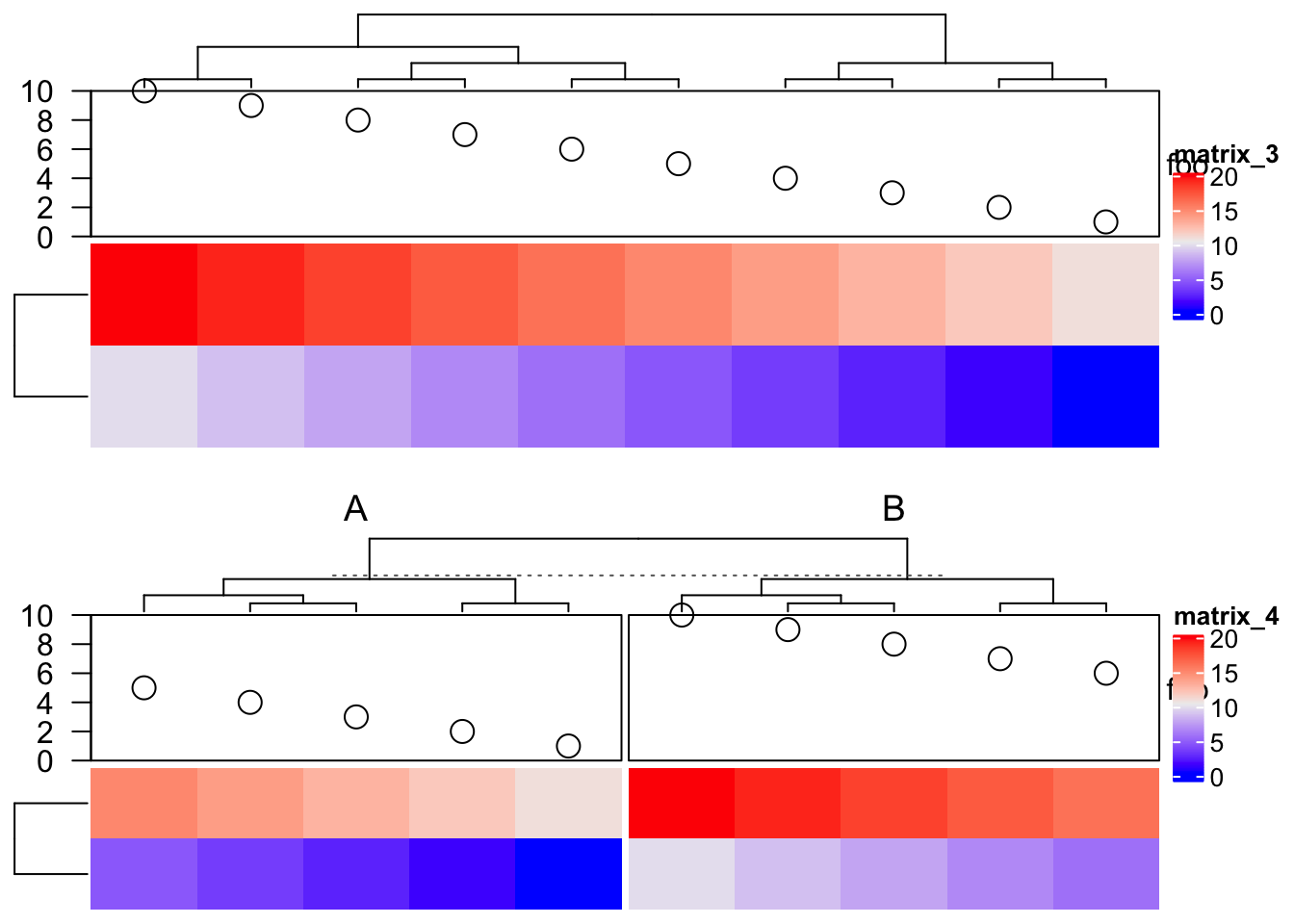
The second way is to put all data variables inside the function and no need to import other variables.
# code only for demonstration
anno2 = AnnotationFunction(
fun = function(index) {
x = 1:10
n = length(index)
pushViewport(viewport())
grid.points(1:n, x[index])
popViewport()
},
n = 10,
subsetable = TRUE
)The most compact way to only specify the function to the constructor.
# code only for demonstration
anno3 = AnnotationFunction(
fun = function(index) {
x = 1:10
n = length(index)
pushViewport(viewport())
grid.points(1:n, x[index])
popViewport()
}
)All the anno_*() functions introduced in this section actually are not
really annotation functions, while they are functions generating annotation
functions with specific configurations. However, users don’t need to be that
aware of.
## An AnnotationFunction object
## function: anno_points()
## position: column
## items: 10
## width: 1npc
## height: 1cm
## imported variable: data_scale, axis_param, border, size, value, pch_as_image, axis, gp, axis_grob, pch
## subsetable variable: gp, value, size, pch
## this object is subsetable
## 5.13831111111111mm extension on the leftIn most cases, you don’t need to manually construct your AnnotationFunction
objects. The annotation function anno_*() implemented in ComplexHeatmap
are already enough for most of the analysis tasks. On the other hand, users
can also use anno_empty() and decorate_annotation() to quickly add
self-defined annotation graphics. E.g. we can re-implement previous heatmap
as:
ht = Heatmap(m, top_annotation = HeatmapAnnotation(foo = anno_empty(height = unit(2, "cm"))),
column_split = rep(c("A", "B"), each = 5))
ht = draw(ht)
co = column_order(ht)
decorate_annotation("foo", slice = 1, {
od = co[[1]]
pushViewport(viewport(xscale = c(0.5, length(od) + 0.5), yscale = range(x)))
grid.points(seq_along(od), x[od])
grid.yaxis()
popViewport()
})
decorate_annotation("foo", slice = 2, {
od = co[[2]]
pushViewport(viewport(xscale = c(0.5, length(od) + 0.5), yscale = range(x)))
grid.points(seq_along(od), x[od])
popViewport()
})